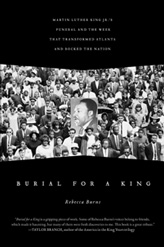Editorial
Front Page - Friday, January 14, 2011
The Bookworm
“Burial for a King: Martin Luther King Jr’s Funeral and the Week That Transformed Atlanta and Rocked the Nation”
Terri Schlichenmeyer

In days of old, when someone messed with a King, he was usually thrown in the dungeon without trial or jury. Justice was swift and mercy was rare.
That’s because, oftentimes, the King held things together. Loved or hated, he was a force to be reckoned with. He had power and powerful friends, and messing with him wasn’t advised. On that subject, little has changed through the centuries, as you’ll see in “Burial for a King” by Rebecca Burns.
Xernona Clayton was working on an unusual project the night that Martin Luther King, Jr. was shot: she was trying to set up a meeting between King and Calvin Craig of the Ku Klux Klan. As King’s director of public relations, Clayton was used to hoaxes; when a waitress handed her a note that said Dr. King had been shot, she ignored it.
When she realized it was true, she hurried to Coretta King’s side.
Robert Kennedy was told about the shooting shortly after it happened. He spoke briefly to a small crowd of supporters, mentioning his brother’s assassination (something he rarely discussed). When he finished talking, he went to his hotel and wept.
Media swooped in on Mem-phis’ Lorraine Motel on the evening that Dr. King was killed. News cameras captured J. Edgar Hoover’s FBI working the scene. They also captured the hotel’s housekeeper as she tried to scrub bloodstains from the balcony.
Georgia’s Governor Lester Maddox, fiercely against integration, refused to lower the capital’s flags on the day after Dr. King was assassinated. He capitulated when advised that he was disobeying a federal mandate.
There was violence in almost all major cities in the days after Dr. King was shot. Riots broke out and entire neighborhoods burned. Unbelievably, some officials incited rioting. Others begged for it to end.
Thousands of people descended upon Atlanta for Dr. King’s funeral. They slept on church pews and park benches for a chance to squeeze near Ebenezer Baptist Church, barely allowing mourners to pass or the coffin to be placed on the wagon that bore it to the cemetery. And when everything was done and the celebrities went home, Dr. King’s body was quietly moved, and moved again.
Over the last 40-some years, a lot has been written about Dr. King, his assassination, and his work. “Burial of a King” takes things beyond, in an almost minute-by-minute account of a weekend that witnesses will never forget.
And you’ll never forget this book. Through interviews, letters, personal accounts and papers kept by mourners and others, author Rebecca Burns allows readers to peek at the smaller moments that filled that historic time: babies born and elders dead, laughter amid the tears, jaw-droppingly misplaced words, families changed by small actions and life continuing.
Anyone old enough to remember Dr. King’s assassination will appreciate this deep look at what happened surrounding that day. Anyone younger will enjoy the perspective given in this book. Either way, for readers interested in cultural history, “Burial for a King” could be the crown on your bookshelf.
The Bookworm is Terri Schli-chenmeyer. Terri has been reading since she was three years old and she never goes anywhere without a book. She lives on a hill in Wisconsin with two dogs and 12,000 books.
|
|